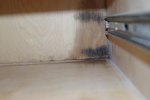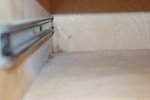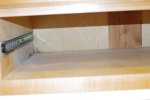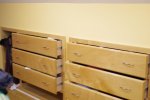Looks like condensation to me. I'm wondering about air movement.
I've had this sort of thing in two houses now. In both houses there was a closet that ran along an outside wall. If we piled clothes up on the shelf right against the wall, then over the winter it would get cold there and you'd get moisture and mold. Our solution was to have an air gap.
Couple years ago I built a bonus room over the garage. It's well insulated, but still, it's over a garage, so it is not as warm as the house. While my daughters bed was being built I just threw a mattress on the floor right in the corner, an outside corner. After a month, there was mold growing on the baseboard behind the mattress. Again, the issue was that it was an outside corner, with no air movement.
Insulation in most(?) houses only slows the transmission of heat, it does not stop it. Here you've got an exposed area sticking out into the kneewall, so I'm betting that it's gradually going to get cold in those corners up against the insulation, and moisture will condense there which leads to mold. Is there any way you can get some air circulation through that space?
 any ideas on how to fix the problem?
any ideas on how to fix the problem?















